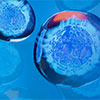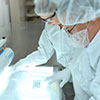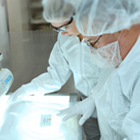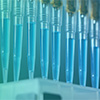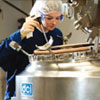Protéines et Peptides
Numéro de catalogue:
(PRSI91-169)
Fournisseur:
ProSci Inc.
Description:
Ubiquitin Carboxyl-Terminal Hydrolases (UCHs) are a family of cysteine hydrolases. They catalyze the hydrolysis of amides, thioesters and esters, peptide and isopeptide bonds formed by the C-terminal Gly of ubiquitin. Up regulation of UCHL3 is associated with uterine cervical neoplasms. UCHL3 is implicated in age related cognitive disorders. UCHL3 also promotes adipogenesis and insulin signaling. In mice, UCHL3 knockout have been shown to be resistant to diet-induced obesity.
UOM:
1 * 50 µG
Numéro de catalogue:
(PRSI96-729)
Fournisseur:
ProSci Inc.
Description:
Tumor necrosis factor receptor 1 (TNF-R1) is also known as Tumor necrosis factor receptor superfamily member 1A (TNFRSF1A), TNFAR, CD antigen CD120a, which belongs to the tumor necrosis factor receptor superfamily. TNF-R1 contains one death domain and four TNFR-Cys repeats. TNF-R1 is the receptor of TNFSF2 / TNF-alpha and homotrimeric TNFSF1 / lymphotoxin - alpha. The adapter molecule FADD recruits caspase-8 to the activated receptor. The resulting death-inducing signaling complex (DISC) performs caspase-8 proteolytic activation which initiates the subsequent cascade of caspases (aspartate-specific cysteine proteases) mediating apoptosis. TNF-R1 contributes to the induction of non - cytocidal TNF effects including anti-viral state and activation of the acid sphingomyelinase. Defects in TNFRSF1A are the cause of familial hibernian fever (FHF).
UOM:
1 * 1 EA
Numéro de catalogue:
(PRSI96-739)
Fournisseur:
ProSci Inc.
Description:
Tumor necrosis factor receptor superfamily member 11B (TNFRSF11B) is also known as Osteoclastogenesis inhibitory factor (OCIF), Osteoprotegerin (OPG). TNFRSF11B is a secreted homodimer protein, which can interact with TNFSF10 and TNFSF11. TNFRSF11B acts as decoy receptor for TNFSF11/RANKL and thereby neutralizes its function in osteoclastogenesis. TNFRSF11B inhibits the activation of osteoclasts and promotes osteoclast apoptosis in vitro. Bone homeostasis seems to depend on the local ratio between TNFSF11 and TNFRSF11B. TNFSF10/TRAIL binding blocks the inhibition of osteoclastogenesis.
UOM:
1 * 1 EA
Numéro de catalogue:
(PRSI91-872)
Fournisseur:
ProSci Inc.
Description:
Human Chemokine (C-C Motif) Ligand 8 (CCL8) is produced by human MG63 osteosarcoma cells. CCL8 shares 62% and 58% amino acid sequence identity with MCP-1 and MCP-3, respectively. All three MCP proteins are monocyte chemoattractants. CCL8 is chemotactic for and activates many different immune cells, including mast cells, eosinophils and basophils, which are implicated in allergic response, and monocytes, T cells, and NK cells that are involved in the inflammatory response. CCL8 elicits its effects by binding to several different cell surface receptors including CCR1, CCR2B and CCR5.
UOM:
1 * 50 µG
Numéro de catalogue:
(PRSI91-874)
Fournisseur:
ProSci Inc.
Description:
Interleukin-8 (IL-8) belongs to the neutrophil-specific CXC family of chemokines. It is one of the initial cytokines released from a variety of cell types, including T cells, endothelial cells and fibroblasts, in response to an inflammatory stimulus and acts by recruiting neutrophils, T-cells and basophils to the site of inflammation. Elevated Interleukin-8 levels are associated with the onset of a variety of disease states.
UOM:
1 * 50 µG
Numéro de catalogue:
(PRSI91-881)
Fournisseur:
ProSci Inc.
Description:
B- and T-Lymphocyte Attenuator (BTLA) is a single-pass type I membrane protein containing 1 Ig-like V-type (immunoglobulin-like) domain. BTLA expression is induced during activation of T cells, and BTLA remains expressed on Th1 cells but not Th2 cells. Like PD1 and CTLA4, BTLA interacts with a B7 homolog, B7H4. However, unlike PD-1 and CTLA-4, BTLA displays T-Cell inhibition via interaction with tumor necrosis family receptors (TNF-R), not just the B7 family of cell surface receptors. BTLA is a lymphocyte inhibitory receptor that inhibits lymphocytes during immune response. BTLA also is a ligand for tumor necrosis factor (receptor) superfamily, member 14 (TNFRSF14), also known as herpes virus entry mediator (HVEM). BTLA-HVEM complexes negatively regulate T-cell immune responses.
UOM:
1 * 50 µG
Numéro de catalogue:
(PRSI91-279)
Fournisseur:
ProSci Inc.
Description:
Protein NDRG1 is a member of the N-Myc Downregulated Gene family, which is part of the alpha/ beta Hydrolase superfamily. Protein NDRG1 is a cytoplasmic protein that is involved in stress responses, hormone responses, cell growth and differentiation. Protein NDRG1 is necessary for p53-mediated caspase activation and apoptosis. Protein NDRG1 mutuations are reported to be the cause for hereditary motor and sensory neuropathy-Lom. Decreased NDRG1 expression in glioma is linked to tumor progression; overexpression of NDRG1 is connected to malignant status of esophageal cancer.
UOM:
1 * 50 µG
Numéro de catalogue:
(PRSI7281P)
Fournisseur:
ProSci Inc.
Description:
17 amino acids near the carboxy terminus of human MTERFD1.
UOM:
1 * 50 µG
Numéro de catalogue:
(PRSI40-617)
Fournisseur:
ProSci Inc.
Description:
GM-CSF is a hematopoietic growth factor that stimulates the development of neutrophils and macrophages and promotes the proliferation and development of early erythroid megakaryocytic and eosinophilic progenitor cells. It is produced in by endothelial cells, monocytes, fibroblasts and T-lymphocytes. GM-CSF inhibits neutrophil migration and enhances the functional activity of the mature end-cells. The human and murine molecules are species-specific and exhibit no cross-species reactivity. Recombinant rat GM-CSF is a 14.5 kDa globular protein consisting of 128 amino acids residues. Recombinant human GM-CSF is a 14.6 kDa globular protein consisting of 128 amino acids containing two intramolecular disulfide bonds and two potential N-linked glycosylation sites. Recombinant murine GM-CSF (40-617) is a 14.2 kDa globular protein consisting of 124 amino acids residues. Recombinant murine GM-CSF (40-621) is a 14.5 kDa globular protein consisting of 128 amino acids residues.
UOM:
1 * 20 µG
Numéro de catalogue:
(PRSI92-554)
Fournisseur:
ProSci Inc.
Description:
OX40, also termed CD134 and TNFRSF4, is a T cell co-stimulatory molecule of the TNF receptor superfamily which plays a key role in the survival and homeostasis of effector and memory T cells. OX40 is expressed on CD4+ and CD8+ T cells upon engagement of the TCR by antigen presenting cells along with co-stimulation by CD40-CD40 Ligand and CD28-B7. The interaction between OX40 and OX40 ligand (OX40 L) will occur when activated T cells bind to professional antigen-presenting cells (APCs). The T-cell functions, including cytokine production, expansion, and survival, are then enhanced by the OX40 costimulatory signals. OX40 signals are critical for controllling the function and differentiation of Foxp3+ regulatory T cells. OX40-OX40 L interaction regulates T-cell tolerance, peripheral T-cell homeostasis, and T-cell-mediated inflammatory diseases.
UOM:
1 * 50 µG
Numéro de catalogue:
(PRSI92-551)
Fournisseur:
ProSci Inc.
Description:
Lymphocyte-activation gene 3 (LAG3), also known as CD223, is a type I transmembrane protein with four extracellular Ig-like domains, designated D1 to D4 and belongs to the immunoglobulin superfamily. The gene for LAG3 lies adjacent to the gene for CD4 on human chromosome 12p13.32 and shares approximately 20% identical to the CD4 gene. LAG3 is expressed on activated T cells, natural killer cells, B cells and plasmacytoid dendritic cells. LAG3 binds with high affinity to MHC class II molecules, and it interferes competitively with the binding of CD4 to MHC class II and thereby blocks the transduction of stimulatory signals mediated by this interaction. LAG3 negatively regulates cellular proliferation, activation, and homeostasis of T cells, and plays an important role in Treg suppressive function. LAG3 is the target of various drug development programs to develop new treatments for cancer and autoimmune disorders. The soluble form, sLAG-3, is being developed as a cancer drug.
UOM:
1 * 50 µG
Numéro de catalogue:
(PRSI6495P)
Fournisseur:
ProSci Inc.
Description:
RILPL1 peptide is used for blocking the activity of RILPL1 antibody.
UOM:
1 * 50 µG
Numéro de catalogue:
(PRSI7229P)
Fournisseur:
ProSci Inc.
Description:
17 amino acids near the carboxy terminus of human GRIP1.
UOM:
1 * 50 µG
Numéro de catalogue:
(PRSI7225P)
Fournisseur:
ProSci Inc.
Description:
17 amino acids near the center of human NELF.
UOM:
1 * 50 µG
Numéro de catalogue:
(PRSI7223P)
Fournisseur:
ProSci Inc.
Description:
18 amino acids near the carboxy terminus of human CCNT1.
UOM:
1 * 50 µG
Numéro de catalogue:
(PRSI92-390)
Fournisseur:
ProSci Inc.
Description:
Myelin protein zero-like protein 1(MPZL1) is encoded by the MPZL1 gene, which is a single-pass type I membrane protein. It is widely expressed with highest levels in heart, placenta, kidney and pancreas. As cell surface receptor, it involved in signal transduction processes. MPZL1 recruits PTPN11/SHP-2 to the cell membrane and subsequently activate/phosphorylate Src kinase at Tyr426, promoting phosphorylation of cortactin and migration of HCC cells. MPZL1also is a major receptor for concanavalin-A (ConA) and involved in cellular signalling induced by ConA, which probably includes Src family tyrosine-protein kinases.
UOM:
1 * 50 µG
Appel de prix
Le stock de cet article est limité mais peut être disponible dans un entrepôt proche de vous. Merci de vous assurer que vous êtes connecté sur le site afin que le stock disponible soit affiché. Si l'
Le stock de cet article est limité mais peut être disponible dans un entrepôt proche de vous. Merci de vous assurer que vous êtes connecté sur le site afin que le stock disponible soit affiché. Si l'
Ces articles ne peuvent être ajoutés au Panier. Veuillez contacter votre service client ou envoyer un e-mail à vwr.be@vwr.com
Une documentation supplémentaire peut être nécessaire pour l'achat de cet article. Un représentant de VWR vous contactera si nécessaire.
Ce produit a été bloqué par votre organisation. Contacter votre service d'achat pour plus d'informations.
Le produit original n'est plus disponible. Le remplacement représenté est disponible
Les produits marqués de ce symbole ne seront bientôt plus disponibles - vente jusqu'à épuisement de stock. Des alternatives peuvent être disponibles en recherchant le code article VWR indiqué ci-dessus. Si vous avez besoin d'une assistance supplémentaire, veuillez contacter notre Service Clientèle au 016 385 011.
|
|||||||||




